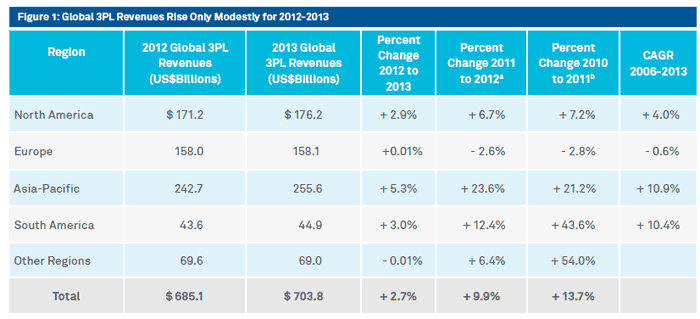From SCDigest's On-Target E-Magazine
- Oct. 1, 2014 -
Supply Chain News: Highlights from the 19th Annual Third-Party Logistics Study
Spend on Outsourcing in North America and Europe Seems to be Slowing, while "IT Gap" Continues to Shrink
SCDigest Editorial Staff
For the 19th consecutive year, Dr. John Langley of Penn State University has led the annual Third Party Logistics Study, released again this year at the CSCMP conference in San Antonio last week.
The data, based on survey responses from hundreds of shippers and 3PLs worldwide, doesn't usually change all that much from year to year, but some overall trends are clearly discernible. One important question is whether the rapid growth of outsourced logistics is slowing or even flatlining a bit - a big change from the past decade.
In general, shippers and 3PLs seem to be ever more satisfied with their mutual relationships, and slowly but surely shipper satisfaction with 3PL IT capabilities continues to increase.
SCDigest Says: |
 |
| SCDigest wonders if the level of outsourcing as a percent of total logistics spend may not be reaching a sort of ceiling, where outsourcing spend will not grow by much more than overall GDP growth in coming years. |
|
What Do You Say?
|
|
|
|
That said, there are still gaps in the how collaborative and strategic outsourcing relationships really are versus the avowed intentions of both sides.
Once again this year, the report highlights several major themes and trends, in addition to the basic survey responses that generally remain close to the same from any one year to year. For this 2015 report, those focus issues were omni-channel fuflillment, workforce management, CRM and mobile technologies, and Mexico.
This week, SCDigest will summarize highlights of the main body of the report. Next week, we will do the same for the focus areas of the 2015 study.
The rate of growth in 3PL spending appears to have slowed in North America in 2013.
As shown in the chart below from the report, based on data from Armstrong & Associates, 3PL revenues in North America were up just 2.9% last year versus 2012. That is well down from the 6.7% growth seen the prior year, and likely under the rate of underlying economic growth, which has not usually been the case for spending on outsourcing over the past two decades.
While we don't have a figure for all of North America to compare, US nominal GDP rose 3.4% in 2013, above the 2.9% growth in North American 3PL revenues.
European outsource spending was basically flat, in an economy that was about the same, while 3PLs in South America saw 3% growth and those in Asia the strongest numbers at 5.3% revenue gains.
Changes in 3PL Spend by Region 2012 t0 2013

Source: 2015 3PL Study, from Data from Armstrong & Associates
The long run cumulative average growth rate, or CAGR, is also trending down, at last in North America and Europe. The former has seen a CAGR of just 4% since 2006, while 3PL spend in Europe has actually seen slightly negative growth over that period. Asia and South America have seen much faster growth, both over 10%. Of course, the economies of those two regions have also growth much more rapidly over that time than the developed word.
The 3PL report notes that "it appears that the cooling off of many global economies may be responsible for the somewhat slower or limited growth in 3PL revenues throughout the regions of the world."
That is undoubtedly true, but SCDigest wonders if the level of outsourcing as a percent of total logistics spend may not be reaching a sort of ceiling, where outsourcing spend will not grow by much more than overall GDP growth in coming years.
That contention is supported by this year's data, where shippers reported an average of 36% of their total logistics expenditures are related to outsourcing. That is down a lot from the average of 44% reported
last year and 42% reported in the year before that.
There is always some "noise" in any such survey data, so the specific numbers in any given year should be taken with a grain of salt, but the general trend does seem to show a decline in the percent of outsourcing spend. The report notes there were some changes in the survey population this year that could also account for the changes in these data points.
That said, the data does not support the idea that shippers are heavily increasing their "insourcing" of logistics activities. 67% of shippers indicate they are increasing their use of outsourced logistics services this year, though that us down from the 72% of shippers moving that direction in 2012.
Conversely, just 26%
of shippers report they are returning to
insourcing at least some of their logistics
activities. But that is up from the 23% the previous year.
As others have noted, in general there is also a trend to consolidate the numbers of 3PLs a company uses. 53% of shippers say they are working to reduce the total number of 3PLs with which they work - down just a bit from the 56% of respondents who felt that way in 2012.
A full 92% of shippers say that their work with 3PLs have generally been successful, a number that continues to slowly rise over time. Meanwhile, an almost unanimous 98% of 3PLs consider their relationships with shippers generally successful.
(Distribution/Materials Handling Story Continues Below
)
|